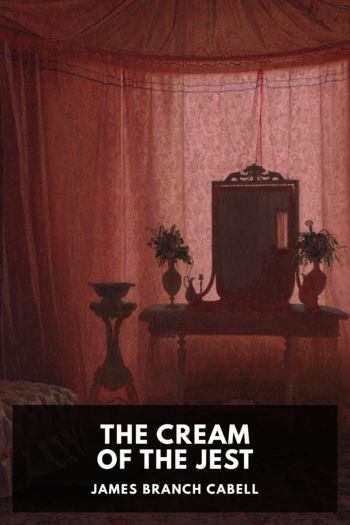The Cream of the Jest, James Branch Cabell [smart ebook reader .TXT] 📗

- Author: James Branch Cabell
Book online «The Cream of the Jest, James Branch Cabell [smart ebook reader .TXT] 📗». Author James Branch Cabell
That the plot of this romance began with Eden and reached its climax at Calvary, Kennaston was persuaded, solely and ardently, because of the surpassing beauty of the Christ-legend. No other myth compared with it from an aesthetic standpoint. He could imagine no theme more adequate to sustain a great romance than this of an Author suffering willingly for His puppets’ welfare; and mingling with His puppets in the similitude of one of them; and able to wring only contempt and pity from His puppets—since He had not endowed them with any faculties wherewith to comprehend their Creator’s nature and intent. Indeed, it was pretty much the plight which Kennaston had invented for his own puppets at Storisende, as Kennaston complacently reflected. It was the most tremendous situation imaginable; and quite certainly no Author could ever have failed to perceive, and to avail Himself of, its dramatic possibilities. To conceive that the world-romance did not center upon Calvary was to presume an intelligent and skilled Romancer blind to the basic principles of His art. His sense of pathos and of beauty and of irony could have led Him to select no other legend. And in the inconsistencies and unsolved problems, or even the apparent contradictions, of Christianity, Felix Kennaston could see only a possible error or omission on the Author’s part, such as was common to all romances. A few errata did not hamper the tale’s worth and splendor, or render it a whit less meritorious of admiration. …
And, indeed, Felix Kennaston found that his theory of the Atonement was in harmony with quite orthodox teachings. The library at Alcluid revealed bewildered and perturbed generations at guesswork. How could a God have been placated, and turned from wrath to benevolence, by witnessing the torment of His own son? What pleasure, whereby He was propitiated, could the God have derived from watching the scene on Calvary? Or was the God, as priests had taught so long (within the same moment that they proclaimed the God’s omnipotence) not wholly a free agent, because bound by laws whereby He was compelled to punish someone for humanity’s disobedience, with the staggering option of substituting an innocent victim? For if you granted that, you conceded to be higher than the God, and overruling Him, a power which made for flat injustice. Since Schleiermacher’s time, at least, as Kennaston discovered, there had been reasoning creatures to contest the possibility of such discrepant assumptions, and a dynasty of teachers who adhered to the “subjective” theory of propitiation. For these considered that Christ came, not primarily to be crucified, but by his life to reveal to men the nature of their God. The crucifixion was an incidental, almost inevitable, result of human obtuseness; and was pregnant with value only in that thereby the full extent of divine love was perfectly evinced. The personality, rather than the sufferings, of the Nazarene had thus satisfied, not any demand or attribute of the God by acting upon it from without, “but God’s total nature by revealing it and realizing it in humanity.” The God, in short, had satisfied Himself “by revealing and expressing His nature” in the material universe, precisely as lesser artists got relief from the worries of existence by depicting themselves in their books. Just as poets express themselves communicatively in words, so here the Author had expressed Himself in flesh. Such, in effect, had been the teaching of Karl Immanuel Nitzsch, of Richard Rothe, and of von Hofman, in Germany; of Auguste Bouvier in Geneva; of Alexandre Vinet, and of Auguste Sabatier, in France; of Frederick Denison Maurice, and John Caird, and Benjamin Jowett, in England; and in America of Horace Bushnell, and Elisha Mulford, and William Newton Clarke. The list was imposing: and Kennaston rejoiced to find himself at one with so many reputable theologians. For all these scholars had dimly divined, with whatever variousness they worded the belief, that the God’s satisfaction sprang, in reality, from the consciousness of having at last done a fine piece of artistic work, in creating the character of Christ. …
So, as nearly as one can phrase the matter, it was really as a proof of confidence in his Author’s literary abilities that Felix Kennaston was presently confirmed at our little country church, to the delight of his wife and the approbation of his neighbors. It was felt to be eminently suitable: that such a quiet well-to-do man of his years and station should not be a communicant was generally, indeed, adjudged unnatural. And when William T. Vartrey (of the Lichfield Iron Works) was gathered to his grandfathers, in the following autumn, Mr. Kennaston was rather as a matter of course elected to succeed him in the vestry. And Kennaston was unfeignedly pleased and flattered.
To the discerning it is easy enough to detect in all this fantastic theorizing the man’s obsessing love of ordered beauty and his abhorrence of slovenliness—of shapelessness—which make his writings so admirable, here





Comments (0)